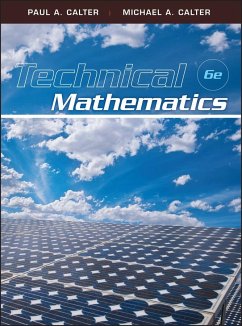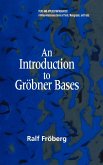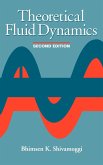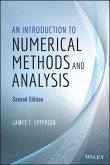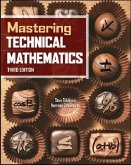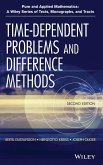- Gebundenes Buch
- Merkliste
- Auf die Merkliste
- Bewerten Bewerten
- Teilen
- Produkt teilen
- Produkterinnerung
- Produkterinnerung
This textbook has been in constant use since 1980, and this edition represents the first major revision of this text since the second edition. It was time to select, make hard choices of material, polish, refine, and fill in where needed. Much has been rewritten to be even cleaner and clearer, new features have been introduced, and some peripheral topics have been removed.
The authors continue to provide real-world, technical applications that promote intuitive reader learning. Numerous fully worked examples and boxed and numbered formulas give students the essential practice they need to…mehr
Andere Kunden interessierten sich auch für
![Multi-Objective Optimization Using Evolutionary Algorithms Multi-Objective Optimization Using Evolutionary Algorithms]() Kalyanmoy DebMulti-Objective Optimization Using Evolutionary Algorithms103,99 €
Kalyanmoy DebMulti-Objective Optimization Using Evolutionary Algorithms103,99 €![Linear Programming and Network Flows Linear Programming and Network Flows]() Mokhtar S. BazaraaLinear Programming and Network Flows161,99 €
Mokhtar S. BazaraaLinear Programming and Network Flows161,99 €![An Introduction to Gröbner Bases An Introduction to Gröbner Bases]() Ralf FröbergAn Introduction to Gröbner Bases179,99 €
Ralf FröbergAn Introduction to Gröbner Bases179,99 €![Theoretical Fluid Dynamics Theoretical Fluid Dynamics]() Bhimsen K. ShivamoggiTheoretical Fluid Dynamics257,99 €
Bhimsen K. ShivamoggiTheoretical Fluid Dynamics257,99 €![An Introduction to Numerical Methods and Analysis An Introduction to Numerical Methods and Analysis]() James F. EppersonAn Introduction to Numerical Methods and Analysis140,99 €
James F. EppersonAn Introduction to Numerical Methods and Analysis140,99 €![Mastering Technical Mathematics, Third Edition Mastering Technical Mathematics, Third Edition]() Stan GibiliscoMastering Technical Mathematics, Third Edition44,99 €
Stan GibiliscoMastering Technical Mathematics, Third Edition44,99 €![Time-Dependent Problems 2e Time-Dependent Problems 2e]() Bertil GustafssonTime-Dependent Problems 2e162,99 €
Bertil GustafssonTime-Dependent Problems 2e162,99 €-
-
-
This textbook has been in constant use since 1980, and this edition represents the first major revision of this text since the second edition. It was time to select, make hard choices of material, polish, refine, and fill in where needed. Much has been rewritten to be even cleaner and clearer, new features have been introduced, and some peripheral topics have been removed.
The authors continue to provide real-world, technical applications that promote intuitive reader learning. Numerous fully worked examples and boxed and numbered formulas give students the essential practice they need to learn mathematics. Computer projects are given when appropriate, including BASIC, spreadsheets, computer algebra systems, and computer-assisted drafting. The graphing calculator has been fully integrated and calculator screens are given to introduce computations. Everything the technical student may need is included, with the emphasis always on clarity and practical applications.
The authors continue to provide real-world, technical applications that promote intuitive reader learning. Numerous fully worked examples and boxed and numbered formulas give students the essential practice they need to learn mathematics. Computer projects are given when appropriate, including BASIC, spreadsheets, computer algebra systems, and computer-assisted drafting. The graphing calculator has been fully integrated and calculator screens are given to introduce computations. Everything the technical student may need is included, with the emphasis always on clarity and practical applications.
Produktdetails
- Produktdetails
- Verlag: Wiley & Sons
- 6. Aufl.
- Seitenzahl: 832
- Erscheinungstermin: 22. März 2011
- Englisch
- Abmessung: 282mm x 223mm x 34mm
- Gewicht: 1715g
- ISBN-13: 9780470534922
- ISBN-10: 0470534923
- Artikelnr.: 31198775
- Verlag: Wiley & Sons
- 6. Aufl.
- Seitenzahl: 832
- Erscheinungstermin: 22. März 2011
- Englisch
- Abmessung: 282mm x 223mm x 34mm
- Gewicht: 1715g
- ISBN-13: 9780470534922
- ISBN-10: 0470534923
- Artikelnr.: 31198775
Paul A. Calter is a Visiting Scholar at Dartmouth College and Professor Emeritus of Mathematics at Vermont Technical College. He is a book review editor of the Nexus Network Journal and has interests in both the fields of mathematics and art. He received his B.S. from Cooper Union and his M.S. from Columbia University, both in engineering, and his Masters of Fine Arts Degree from Norwich University. Calter has taught mathematics for over twenty-five years and is the author of ten mathematics textbooks and a mystery novel. He has been an active painter and sculptor since 1968, has had many solo shows and participated in dozens of group art shows, and has permanent outdoor sculptures at a number of locations. Calter developed a course called "Geometry in Art & Architecture," which he has taught at Dartmouth College and Vermont Technical College, and he has taught at Dartmouth College and Vermont Technical College, and he has given workshops and lectures on the subject. Calter's own art is concerned with astronomical and geometric themes; he searches for a link between the organic and geometric basis of beauty, what has been called the philosopher's stone of aesthetics.
1. Review of Numerical Computation. 1
1. The Real Numbers 1
2. Addition and Subtraction. 1
3. Multiplication. 1
4. Division. 1
5. Powers and Roots. 1
6. Combined Operations. 1
7. Scientific Notation and Engineering Notation. 1
8. Units of Measurements. 1
9. Percentage. Chapter 1. Review Problems. 2. Introduction to Algebra. 2
1. Algebraic Expressions. 2
2. Addition and Subtraction of Polynomials. 2
3. Laws of Exponents. 2
4. Product of Two Monomials. 2
5. Product of a Multinomial and a Monomial. 2
6. Product of Two Binomials. 2
7. Product of Two Multinomials. 2
8. Powers of Multinomials. 2
9. Removing Symbols of Grouping. 2
10. Quotient of Two Monomials. 2
11. Dividing a Polynomial by a Monomial. 2
12. Quotient of Two Polynomials. Chapter 2. Review Problems. 3. Simple Equations and Word Problems. 3
1. Solving First
Degree Equations. 3
2. Solving Word Problems. 3
3. Uniform Motion. 3
4. Financial. 3
5. Mixtures. 3
6. Statics. Chapter 3. Review Problems. 4. Functions and Graphs. 4
1. Functions. 4
2. Graphing a Function. 4
3. Graphing a Function by Calculator. 4
4. Solving Equations Graphically. 4
5. More on Functions. 4
6. Straight Line Graphing. Chapter 4. Review Problems. 5. Geometry. 5
1. Straight Lines and Angles. 5
2. Triangles. 5
3. Quadrilaterals. 5
4. The Circle. 5
5. Volumes and Areas of Solids. Chapter 5. Review Problems. 6. Right Triangles. 6
1. The Trigonometric Functions. 6
2. Solution of Right Triangles. 6
3. Applications of the Right Triangle. 6
4. Introduction to Vectors. 6
5. Applications of Vectors. Chapter 6. Review Problems. 7. Oblique Triangles and Vectors. 7
1. Trigonometric Functions of Any Angle. 7
2. Finding the Angle When the Trigonometric Function Is Known. 7
3. Law of Sines. 7
4. Law of Cosines. 7
5. Applications. 7
6. Resultants of Nonperpendicular Vectors. Chapter 7. Review Problems. 8. Systems of Linear Equations. 8
1. Systems of Two Linear Equations 8
2. Other Systems of Equations 8
3. Applications 8
4. Systems of Three Linear Equations Chapter 8. Review Problems 9. Determinants and Matrices. 9
1. Introduction to Matrices. 9
2. Solving a System of Equations by the Unit Matrix Method. 9
3. Second
Order Determinants. 9
4. Higher
Order Determinants. Chapter 9. Review Problems. 10. Factors and Fractions. 10
1. Common Factors. 10
2. Difference of Two Squares. 10
3. Factoring Trinomials. 10
4. Other Factorable Trinomials. 10
5. Simplification of Fractions. 10
6. Multiplication and Division of Fractions. 10
7. Addition and Subtraction of Fractions. 10
8. Complex Fractions. 10
9. Fractional Equations. 10
10. Literal Equations and Formulas. Chapter 10. Review Problems. 11. Quadratic Equations. 11
1. Solving a Quadratic Equation by Calculator. 11
2. Solving Quadratics by Formula. 11
3. Applications. Chapter 11. Review Problems. 12. Exponents and Radicals. 12
1. Integral Exponents. 12
2. Simplification of Radicals. 12
3. Operations with Radicals. 12
4. Radical Equations. Chapter 12. Review Problems. 13. Radian Measure, Arc Length, and Rotation. 13
1. Radian Measure. 13
2. Arc Length. 13
3. Uniform Circular Motion. Chapter 13. Review Problems. 14. Graphs of the Trigonometric Functions. 14
1. Graphing the Sine Wave by Calculator. 14
2. Manual Graphing of the Sine Wave. 14
3. The Sine Wave as a Function of Time. 14
4. Graphing of the Other Trigonometric Functions. 14
5. Graphing Parametric Equations. 14
6. Graphing in Polar Coordinates. Chapter 14. Review Problems. 15. Trigonometric Identities and Equations. 15
1. Fundamental Identities. 15
2. Sum or Difference of Two Angles. 15
3. Functions of Double Angles and Half
Angles. 15
4. Evaluating Trigonometric Expressions. 15
5. Solving Trigonometric Equations. Chapter 15. Review Problems. 16. Ratio, Proportion, and Variation. 16
1. Ratio and Proportion. 16
2. Similar Figures. 16
3. Direct Variation. 16
4. The Power Function. 16
5. Inverse Variation. 16
6. Functions of More Than One Variable. Chapter 16. Review Problems. 17. Exponential and Logarithmic Functions. 17
1. The Exponential Function. 17
2. Logarithms. 17
3. Properties of Logarithms. 17
4. Exponential Equations. 17
5. Solving Logarithmic Equations. Chapter 17. Review Problems. 18. Complex Numbers. 18
1. Complex Numbers in Rectangular Form. 18
2. Complex Numbers in Polar Form. 18
3. Complex Numbers on the Calculator. 18
4. Vector Operations Using Complex Numbers. 18
5. Alternating Current Applications. Chapter 18. Review Problems. 19. Sequences, Series, and the Binomial Theorem. 19
1. Sequences and Series. 19
2. Arithmetic Progressions. 19
3. Geometric Progressions. 19
4. Infinite Geometric Progressions. 19
5. The Binomial Theorem. Chapter 19. Review Problems. 20. Analytic Geometry. 20
1. The Straight Line. 20
2. The Circle. 20
3. The Parabola. 20
4. The Ellipse. 20
5. The Hyperbola. Chapter 20. Review Problems. 21. Statistics and Probability 22. Derivatives of Algebraic Functions. 22
1. Limits. 22
2. Rate of Change and the Tangent. 22
3. The Derivative. 22
4. Rules for Derivatives. 22
5. Derivative of a Function Raised to a Power. 22
6. Derivatives of Products and Quotients. 22
7. Other Variables, Implicit Relations, and Differentials. 22
8. Higher
Order Derivatives. Chapter 22. Review Problems. Appendix A: Summary of Facts and Formulas. Appendix B: Conversion Factors. Appendix C: Table of Integrals. Appendix D: Answers to Selected Problems. Index.
1. The Real Numbers 1
2. Addition and Subtraction. 1
3. Multiplication. 1
4. Division. 1
5. Powers and Roots. 1
6. Combined Operations. 1
7. Scientific Notation and Engineering Notation. 1
8. Units of Measurements. 1
9. Percentage. Chapter 1. Review Problems. 2. Introduction to Algebra. 2
1. Algebraic Expressions. 2
2. Addition and Subtraction of Polynomials. 2
3. Laws of Exponents. 2
4. Product of Two Monomials. 2
5. Product of a Multinomial and a Monomial. 2
6. Product of Two Binomials. 2
7. Product of Two Multinomials. 2
8. Powers of Multinomials. 2
9. Removing Symbols of Grouping. 2
10. Quotient of Two Monomials. 2
11. Dividing a Polynomial by a Monomial. 2
12. Quotient of Two Polynomials. Chapter 2. Review Problems. 3. Simple Equations and Word Problems. 3
1. Solving First
Degree Equations. 3
2. Solving Word Problems. 3
3. Uniform Motion. 3
4. Financial. 3
5. Mixtures. 3
6. Statics. Chapter 3. Review Problems. 4. Functions and Graphs. 4
1. Functions. 4
2. Graphing a Function. 4
3. Graphing a Function by Calculator. 4
4. Solving Equations Graphically. 4
5. More on Functions. 4
6. Straight Line Graphing. Chapter 4. Review Problems. 5. Geometry. 5
1. Straight Lines and Angles. 5
2. Triangles. 5
3. Quadrilaterals. 5
4. The Circle. 5
5. Volumes and Areas of Solids. Chapter 5. Review Problems. 6. Right Triangles. 6
1. The Trigonometric Functions. 6
2. Solution of Right Triangles. 6
3. Applications of the Right Triangle. 6
4. Introduction to Vectors. 6
5. Applications of Vectors. Chapter 6. Review Problems. 7. Oblique Triangles and Vectors. 7
1. Trigonometric Functions of Any Angle. 7
2. Finding the Angle When the Trigonometric Function Is Known. 7
3. Law of Sines. 7
4. Law of Cosines. 7
5. Applications. 7
6. Resultants of Nonperpendicular Vectors. Chapter 7. Review Problems. 8. Systems of Linear Equations. 8
1. Systems of Two Linear Equations 8
2. Other Systems of Equations 8
3. Applications 8
4. Systems of Three Linear Equations Chapter 8. Review Problems 9. Determinants and Matrices. 9
1. Introduction to Matrices. 9
2. Solving a System of Equations by the Unit Matrix Method. 9
3. Second
Order Determinants. 9
4. Higher
Order Determinants. Chapter 9. Review Problems. 10. Factors and Fractions. 10
1. Common Factors. 10
2. Difference of Two Squares. 10
3. Factoring Trinomials. 10
4. Other Factorable Trinomials. 10
5. Simplification of Fractions. 10
6. Multiplication and Division of Fractions. 10
7. Addition and Subtraction of Fractions. 10
8. Complex Fractions. 10
9. Fractional Equations. 10
10. Literal Equations and Formulas. Chapter 10. Review Problems. 11. Quadratic Equations. 11
1. Solving a Quadratic Equation by Calculator. 11
2. Solving Quadratics by Formula. 11
3. Applications. Chapter 11. Review Problems. 12. Exponents and Radicals. 12
1. Integral Exponents. 12
2. Simplification of Radicals. 12
3. Operations with Radicals. 12
4. Radical Equations. Chapter 12. Review Problems. 13. Radian Measure, Arc Length, and Rotation. 13
1. Radian Measure. 13
2. Arc Length. 13
3. Uniform Circular Motion. Chapter 13. Review Problems. 14. Graphs of the Trigonometric Functions. 14
1. Graphing the Sine Wave by Calculator. 14
2. Manual Graphing of the Sine Wave. 14
3. The Sine Wave as a Function of Time. 14
4. Graphing of the Other Trigonometric Functions. 14
5. Graphing Parametric Equations. 14
6. Graphing in Polar Coordinates. Chapter 14. Review Problems. 15. Trigonometric Identities and Equations. 15
1. Fundamental Identities. 15
2. Sum or Difference of Two Angles. 15
3. Functions of Double Angles and Half
Angles. 15
4. Evaluating Trigonometric Expressions. 15
5. Solving Trigonometric Equations. Chapter 15. Review Problems. 16. Ratio, Proportion, and Variation. 16
1. Ratio and Proportion. 16
2. Similar Figures. 16
3. Direct Variation. 16
4. The Power Function. 16
5. Inverse Variation. 16
6. Functions of More Than One Variable. Chapter 16. Review Problems. 17. Exponential and Logarithmic Functions. 17
1. The Exponential Function. 17
2. Logarithms. 17
3. Properties of Logarithms. 17
4. Exponential Equations. 17
5. Solving Logarithmic Equations. Chapter 17. Review Problems. 18. Complex Numbers. 18
1. Complex Numbers in Rectangular Form. 18
2. Complex Numbers in Polar Form. 18
3. Complex Numbers on the Calculator. 18
4. Vector Operations Using Complex Numbers. 18
5. Alternating Current Applications. Chapter 18. Review Problems. 19. Sequences, Series, and the Binomial Theorem. 19
1. Sequences and Series. 19
2. Arithmetic Progressions. 19
3. Geometric Progressions. 19
4. Infinite Geometric Progressions. 19
5. The Binomial Theorem. Chapter 19. Review Problems. 20. Analytic Geometry. 20
1. The Straight Line. 20
2. The Circle. 20
3. The Parabola. 20
4. The Ellipse. 20
5. The Hyperbola. Chapter 20. Review Problems. 21. Statistics and Probability 22. Derivatives of Algebraic Functions. 22
1. Limits. 22
2. Rate of Change and the Tangent. 22
3. The Derivative. 22
4. Rules for Derivatives. 22
5. Derivative of a Function Raised to a Power. 22
6. Derivatives of Products and Quotients. 22
7. Other Variables, Implicit Relations, and Differentials. 22
8. Higher
Order Derivatives. Chapter 22. Review Problems. Appendix A: Summary of Facts and Formulas. Appendix B: Conversion Factors. Appendix C: Table of Integrals. Appendix D: Answers to Selected Problems. Index.
1. Review of Numerical Computation. 1
1. The Real Numbers 1
2. Addition and Subtraction. 1
3. Multiplication. 1
4. Division. 1
5. Powers and Roots. 1
6. Combined Operations. 1
7. Scientific Notation and Engineering Notation. 1
8. Units of Measurements. 1
9. Percentage. Chapter 1. Review Problems. 2. Introduction to Algebra. 2
1. Algebraic Expressions. 2
2. Addition and Subtraction of Polynomials. 2
3. Laws of Exponents. 2
4. Product of Two Monomials. 2
5. Product of a Multinomial and a Monomial. 2
6. Product of Two Binomials. 2
7. Product of Two Multinomials. 2
8. Powers of Multinomials. 2
9. Removing Symbols of Grouping. 2
10. Quotient of Two Monomials. 2
11. Dividing a Polynomial by a Monomial. 2
12. Quotient of Two Polynomials. Chapter 2. Review Problems. 3. Simple Equations and Word Problems. 3
1. Solving First
Degree Equations. 3
2. Solving Word Problems. 3
3. Uniform Motion. 3
4. Financial. 3
5. Mixtures. 3
6. Statics. Chapter 3. Review Problems. 4. Functions and Graphs. 4
1. Functions. 4
2. Graphing a Function. 4
3. Graphing a Function by Calculator. 4
4. Solving Equations Graphically. 4
5. More on Functions. 4
6. Straight Line Graphing. Chapter 4. Review Problems. 5. Geometry. 5
1. Straight Lines and Angles. 5
2. Triangles. 5
3. Quadrilaterals. 5
4. The Circle. 5
5. Volumes and Areas of Solids. Chapter 5. Review Problems. 6. Right Triangles. 6
1. The Trigonometric Functions. 6
2. Solution of Right Triangles. 6
3. Applications of the Right Triangle. 6
4. Introduction to Vectors. 6
5. Applications of Vectors. Chapter 6. Review Problems. 7. Oblique Triangles and Vectors. 7
1. Trigonometric Functions of Any Angle. 7
2. Finding the Angle When the Trigonometric Function Is Known. 7
3. Law of Sines. 7
4. Law of Cosines. 7
5. Applications. 7
6. Resultants of Nonperpendicular Vectors. Chapter 7. Review Problems. 8. Systems of Linear Equations. 8
1. Systems of Two Linear Equations 8
2. Other Systems of Equations 8
3. Applications 8
4. Systems of Three Linear Equations Chapter 8. Review Problems 9. Determinants and Matrices. 9
1. Introduction to Matrices. 9
2. Solving a System of Equations by the Unit Matrix Method. 9
3. Second
Order Determinants. 9
4. Higher
Order Determinants. Chapter 9. Review Problems. 10. Factors and Fractions. 10
1. Common Factors. 10
2. Difference of Two Squares. 10
3. Factoring Trinomials. 10
4. Other Factorable Trinomials. 10
5. Simplification of Fractions. 10
6. Multiplication and Division of Fractions. 10
7. Addition and Subtraction of Fractions. 10
8. Complex Fractions. 10
9. Fractional Equations. 10
10. Literal Equations and Formulas. Chapter 10. Review Problems. 11. Quadratic Equations. 11
1. Solving a Quadratic Equation by Calculator. 11
2. Solving Quadratics by Formula. 11
3. Applications. Chapter 11. Review Problems. 12. Exponents and Radicals. 12
1. Integral Exponents. 12
2. Simplification of Radicals. 12
3. Operations with Radicals. 12
4. Radical Equations. Chapter 12. Review Problems. 13. Radian Measure, Arc Length, and Rotation. 13
1. Radian Measure. 13
2. Arc Length. 13
3. Uniform Circular Motion. Chapter 13. Review Problems. 14. Graphs of the Trigonometric Functions. 14
1. Graphing the Sine Wave by Calculator. 14
2. Manual Graphing of the Sine Wave. 14
3. The Sine Wave as a Function of Time. 14
4. Graphing of the Other Trigonometric Functions. 14
5. Graphing Parametric Equations. 14
6. Graphing in Polar Coordinates. Chapter 14. Review Problems. 15. Trigonometric Identities and Equations. 15
1. Fundamental Identities. 15
2. Sum or Difference of Two Angles. 15
3. Functions of Double Angles and Half
Angles. 15
4. Evaluating Trigonometric Expressions. 15
5. Solving Trigonometric Equations. Chapter 15. Review Problems. 16. Ratio, Proportion, and Variation. 16
1. Ratio and Proportion. 16
2. Similar Figures. 16
3. Direct Variation. 16
4. The Power Function. 16
5. Inverse Variation. 16
6. Functions of More Than One Variable. Chapter 16. Review Problems. 17. Exponential and Logarithmic Functions. 17
1. The Exponential Function. 17
2. Logarithms. 17
3. Properties of Logarithms. 17
4. Exponential Equations. 17
5. Solving Logarithmic Equations. Chapter 17. Review Problems. 18. Complex Numbers. 18
1. Complex Numbers in Rectangular Form. 18
2. Complex Numbers in Polar Form. 18
3. Complex Numbers on the Calculator. 18
4. Vector Operations Using Complex Numbers. 18
5. Alternating Current Applications. Chapter 18. Review Problems. 19. Sequences, Series, and the Binomial Theorem. 19
1. Sequences and Series. 19
2. Arithmetic Progressions. 19
3. Geometric Progressions. 19
4. Infinite Geometric Progressions. 19
5. The Binomial Theorem. Chapter 19. Review Problems. 20. Analytic Geometry. 20
1. The Straight Line. 20
2. The Circle. 20
3. The Parabola. 20
4. The Ellipse. 20
5. The Hyperbola. Chapter 20. Review Problems. 21. Statistics and Probability 22. Derivatives of Algebraic Functions. 22
1. Limits. 22
2. Rate of Change and the Tangent. 22
3. The Derivative. 22
4. Rules for Derivatives. 22
5. Derivative of a Function Raised to a Power. 22
6. Derivatives of Products and Quotients. 22
7. Other Variables, Implicit Relations, and Differentials. 22
8. Higher
Order Derivatives. Chapter 22. Review Problems. Appendix A: Summary of Facts and Formulas. Appendix B: Conversion Factors. Appendix C: Table of Integrals. Appendix D: Answers to Selected Problems. Index.
1. The Real Numbers 1
2. Addition and Subtraction. 1
3. Multiplication. 1
4. Division. 1
5. Powers and Roots. 1
6. Combined Operations. 1
7. Scientific Notation and Engineering Notation. 1
8. Units of Measurements. 1
9. Percentage. Chapter 1. Review Problems. 2. Introduction to Algebra. 2
1. Algebraic Expressions. 2
2. Addition and Subtraction of Polynomials. 2
3. Laws of Exponents. 2
4. Product of Two Monomials. 2
5. Product of a Multinomial and a Monomial. 2
6. Product of Two Binomials. 2
7. Product of Two Multinomials. 2
8. Powers of Multinomials. 2
9. Removing Symbols of Grouping. 2
10. Quotient of Two Monomials. 2
11. Dividing a Polynomial by a Monomial. 2
12. Quotient of Two Polynomials. Chapter 2. Review Problems. 3. Simple Equations and Word Problems. 3
1. Solving First
Degree Equations. 3
2. Solving Word Problems. 3
3. Uniform Motion. 3
4. Financial. 3
5. Mixtures. 3
6. Statics. Chapter 3. Review Problems. 4. Functions and Graphs. 4
1. Functions. 4
2. Graphing a Function. 4
3. Graphing a Function by Calculator. 4
4. Solving Equations Graphically. 4
5. More on Functions. 4
6. Straight Line Graphing. Chapter 4. Review Problems. 5. Geometry. 5
1. Straight Lines and Angles. 5
2. Triangles. 5
3. Quadrilaterals. 5
4. The Circle. 5
5. Volumes and Areas of Solids. Chapter 5. Review Problems. 6. Right Triangles. 6
1. The Trigonometric Functions. 6
2. Solution of Right Triangles. 6
3. Applications of the Right Triangle. 6
4. Introduction to Vectors. 6
5. Applications of Vectors. Chapter 6. Review Problems. 7. Oblique Triangles and Vectors. 7
1. Trigonometric Functions of Any Angle. 7
2. Finding the Angle When the Trigonometric Function Is Known. 7
3. Law of Sines. 7
4. Law of Cosines. 7
5. Applications. 7
6. Resultants of Nonperpendicular Vectors. Chapter 7. Review Problems. 8. Systems of Linear Equations. 8
1. Systems of Two Linear Equations 8
2. Other Systems of Equations 8
3. Applications 8
4. Systems of Three Linear Equations Chapter 8. Review Problems 9. Determinants and Matrices. 9
1. Introduction to Matrices. 9
2. Solving a System of Equations by the Unit Matrix Method. 9
3. Second
Order Determinants. 9
4. Higher
Order Determinants. Chapter 9. Review Problems. 10. Factors and Fractions. 10
1. Common Factors. 10
2. Difference of Two Squares. 10
3. Factoring Trinomials. 10
4. Other Factorable Trinomials. 10
5. Simplification of Fractions. 10
6. Multiplication and Division of Fractions. 10
7. Addition and Subtraction of Fractions. 10
8. Complex Fractions. 10
9. Fractional Equations. 10
10. Literal Equations and Formulas. Chapter 10. Review Problems. 11. Quadratic Equations. 11
1. Solving a Quadratic Equation by Calculator. 11
2. Solving Quadratics by Formula. 11
3. Applications. Chapter 11. Review Problems. 12. Exponents and Radicals. 12
1. Integral Exponents. 12
2. Simplification of Radicals. 12
3. Operations with Radicals. 12
4. Radical Equations. Chapter 12. Review Problems. 13. Radian Measure, Arc Length, and Rotation. 13
1. Radian Measure. 13
2. Arc Length. 13
3. Uniform Circular Motion. Chapter 13. Review Problems. 14. Graphs of the Trigonometric Functions. 14
1. Graphing the Sine Wave by Calculator. 14
2. Manual Graphing of the Sine Wave. 14
3. The Sine Wave as a Function of Time. 14
4. Graphing of the Other Trigonometric Functions. 14
5. Graphing Parametric Equations. 14
6. Graphing in Polar Coordinates. Chapter 14. Review Problems. 15. Trigonometric Identities and Equations. 15
1. Fundamental Identities. 15
2. Sum or Difference of Two Angles. 15
3. Functions of Double Angles and Half
Angles. 15
4. Evaluating Trigonometric Expressions. 15
5. Solving Trigonometric Equations. Chapter 15. Review Problems. 16. Ratio, Proportion, and Variation. 16
1. Ratio and Proportion. 16
2. Similar Figures. 16
3. Direct Variation. 16
4. The Power Function. 16
5. Inverse Variation. 16
6. Functions of More Than One Variable. Chapter 16. Review Problems. 17. Exponential and Logarithmic Functions. 17
1. The Exponential Function. 17
2. Logarithms. 17
3. Properties of Logarithms. 17
4. Exponential Equations. 17
5. Solving Logarithmic Equations. Chapter 17. Review Problems. 18. Complex Numbers. 18
1. Complex Numbers in Rectangular Form. 18
2. Complex Numbers in Polar Form. 18
3. Complex Numbers on the Calculator. 18
4. Vector Operations Using Complex Numbers. 18
5. Alternating Current Applications. Chapter 18. Review Problems. 19. Sequences, Series, and the Binomial Theorem. 19
1. Sequences and Series. 19
2. Arithmetic Progressions. 19
3. Geometric Progressions. 19
4. Infinite Geometric Progressions. 19
5. The Binomial Theorem. Chapter 19. Review Problems. 20. Analytic Geometry. 20
1. The Straight Line. 20
2. The Circle. 20
3. The Parabola. 20
4. The Ellipse. 20
5. The Hyperbola. Chapter 20. Review Problems. 21. Statistics and Probability 22. Derivatives of Algebraic Functions. 22
1. Limits. 22
2. Rate of Change and the Tangent. 22
3. The Derivative. 22
4. Rules for Derivatives. 22
5. Derivative of a Function Raised to a Power. 22
6. Derivatives of Products and Quotients. 22
7. Other Variables, Implicit Relations, and Differentials. 22
8. Higher
Order Derivatives. Chapter 22. Review Problems. Appendix A: Summary of Facts and Formulas. Appendix B: Conversion Factors. Appendix C: Table of Integrals. Appendix D: Answers to Selected Problems. Index.

